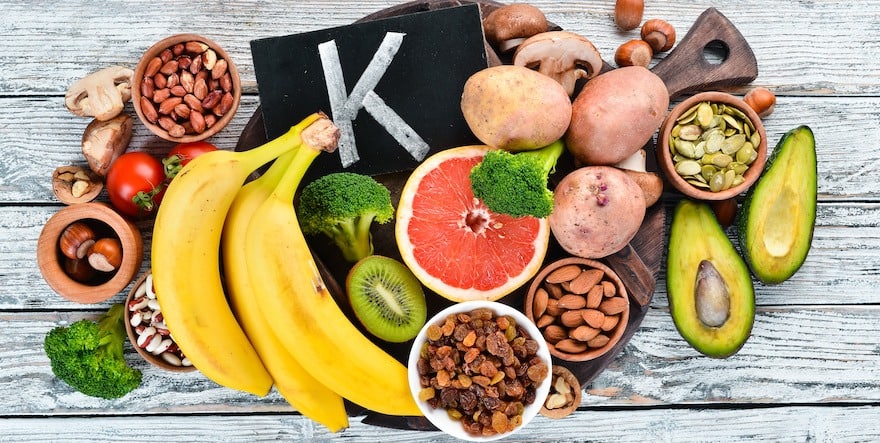Description and functions of potassium in the body
Potassium, represented by the symbol K, is a mineral salt present in every cell of the body. This electrolyte circulates in the body via the blood plasma.
It plays an essential role in several body functions, such as carbohydrate metabolism, the transmission of micro-electric impulses in cells, and maintaining blood pH.
The concentration difference between potassium (and sodium, symbol Na) inside and outside the cell determines the creation of an action potential, an electrical potential that facilitates the circulation of nerve impulses and muscle cell contraction.
This action potential is the basis for the contraction and functioning of all muscle cells in the body.
The blood potassium level is called kaliemia. It ranges from 3.5 to 5 mmol/L. Variations below and above this level define hypokalemia (too low blood potassium level) and hyperkalemia (too high potassium level in the blood).
The benefits of potassium
Potassium is an electrolyte measured by performing a blood ionogram. This blood test determines kaliemia: it is the potassium level in the blood.
This biological examination is often conducted within health check-ups. Indeed, potassium is involved in numerous bodily functions, notably in:
- Muscle contraction
- Maintaining heart rhythm
- The balance of blood pressure variation
- The circulation of nerve impulses
- Maintaining blood volume (volume of circulating blood) in balance with circulating sodium levels (the potassium level affects the water content of cells, hence its influence on blood volume)
- The production of aldosterone, an adrenal hormone that affects the elimination of potassium in favor of sodium (in the context of intercellular mineral salt exchanges). Aldosterone exerts an effect on increasing blood pressure
- Maintaining kidney function and acid-base balance
- The synthesis of proteins and carbohydrates

Maintaining a sufficient potassium level helps prevent heart rhythm disorders and preserves muscle tonus.
Symptoms indicative of a potassium deficiency
Hypokalemia is defined by a blood potassium level below 3.5 mmol/L. Potassium deficiencies (as well as overdoses) can have serious health consequences. Therefore, it is crucial to detect them effectively.
Potassium deficiencies manifest through the following symptoms:
- Weakness or muscle cramps
- Fatigue
- Abdominal pain or constipation
- Tingling sensations in extremities (hands, feet)
- Intestinal transit disruption
- Increase in blood pressure
- Frequent urges to urinate
In cases of moderate hypokalemia, the doctor may prescribe oral treatment. In severe cases, potassium deficiency can lead to heart rhythm disorders, even arrhythmia or muscle paralysis.
The treatment provided involves potassium supplementation intravenously (infusion under medical and paramedical supervision) during hospitalization.
This supplementation is primarily ensured by trained healthcare professionals to avoid complications. Biological monitoring is associated.
The causes of hypokalemia can be attributed to taking diuretic treatments, significant episodes of vomiting or diarrhea (gastroenteritis), low dietary intake (anorexia), or eating disorders (induced vomiting, as in cases of bulimia or anorexia as well).
The use of diuretics is generally associated with the prescription of regular blood ionograms to detect possible potassium deficiencies.
Recommended potassium intake
Potassium intake is easily ensured by a rich and varied diet. The recommended intake to maintain normal kaliemia is as follows:
- Babies aged 6 months to one year: 750 mg/day
- Children aged one to 4 years: 800 mg/day
- Children aged 5 to 7 years: 1,000 to 1,100 mg/day
- Children aged 8 to 10 years: 1,800 mg/day
- Adolescents aged 11 to 14 years: 2,500 to 2,700 mg/day
- Adolescents older than 15 years and adults: 3,500 mg/day
- Breastfeeding women: 4,000 mg/day
Top 5 foods containing potassium
Potassium is found in meats and fish, but also in many fruits and vegetables.
An interesting fact for vegetarians and vegans is that they have the opportunity to ensure their daily intake by adopting a potassium-rich diet. This is possible even though they do not eat meat or animal products.
Here are 5 foods containing this precious nutrient.
Dried fruits

Apricots and raisins, figs, and dried dates are the fruits richest in potassium.
For enthusiasts, it’s better to prepare them following your own recipes to reduce sugar content. Indeed, store-bought dried fruits are very sweet.
It’s best to consume them sparingly, at breakfast with a portion of cottage cheese or as snacks at around 4-5 PM.
Unsweetened cocoa powder

Unsweetened cocoa powder is one of the foods containing the highest amount of potassium. Indeed, 100 g provide around 1,500 mg of potassium. Hence, it’s beneficial to include it in your diet.
Raw cocoa and 70% dark chocolate should also be added to the menu to benefit from an exceptional level of potassium.
Unsweetened cocoa powder is ideal for making hot drinks to savor at breakfast. One or two squares of dark chocolate will perfectly complement your snack breaks.
Chicken

Roast chicken contains 700 mg of potassium per 100 g of food. Opt for skinless chicken breast, which is low in calories, to create your meals.
Roast chicken can be used to make balanced dishes like salads, fresh sandwiches with lettuce and tomatoes, or it can be enjoyed with vegetables and a portion of carbs for lunch or dinner.
The banana

The banana is a safe food. Rich in tryptophan, it is ideal for maintaining sleep, combating stress, and ensuring fiber and magnesium intake.
Preferably consume as it is, without added sugar, for dessert or as a snack.
The avocado

Rich in omega-3, beneficial fatty acids for the brain, avocado also provides a significant amount of potassium (more than 400 mg per 100 g of avocado). This food thus offers several health benefits.
Best consumed fresh, as a starter with the classic avocado-shrimp or in a salad, during a light lunch accompanied by a light vinaigrette.
Potassium can also be found in spinach, potatoes, white beans, or whole wheat pasta.
This element easily dissolves in water. To preserve the potassium level, it’s preferable to use cooking methods like steaming or baking in parchment.
In the case of boiling (like for white beans, potatoes, or whole wheat pasta), it’s helpful to know that the cooking water contains potassium.
Dangers, adverse effects, and potassium overdose
Hyperkalemia (an excessively high potassium level in the blood) should not be taken lightly. It is considered that the blood potassium level is excessively high beyond 5 mmol/L (or beyond 5.5 mmol/L in some cases).
The signs of hyperkalemia are:
- Tremors
- Muscle weakness
- Tingling sensations in the limbs
- Paresthesias (fingers, mouth)
- Nausea/vomiting
- Cardiac rhythm disturbances
Like hypokalemia, severe hyperkalemia can lead to cardiac arrhythmia (or even cardiac arrest). Its consequences should not be neglected.
Hyperkalemia is generally due to acute or chronic renal failure, a diet too rich in potassium (sometimes adopted by some athletes), the presence of diabetes, a cardiovascular disease, or in cases of endocrine disease (notably Addison’s disease, linked to a deficiency in aldosterone, an adrenal hormone regulating the potassium level).
Certain medications, such as some non-steroidal anti-inflammatory drugs or antihypertensive medications, cause hyperkalemia.
To treat this electrolyte imbalance, modifying the diet (limiting or eliminating potassium-containing foods), prescribing diuretics, sodium bicarbonate, or calcium gluconate, depending on the case, can overcome hyperkalemia.
In cases of severe renal insufficiency, hemodialysis is necessary to restore blood potassium levels.
Reminder: The treatment of hyperkalemia is administered under medical and paramedical supervision. Potassium levels are measured regularly until normal levels are restored.
Monitoring of cardiac function is generally associated with it to prevent possible complications. Do not hesitate to consult a doctor if you notice any of the symptoms mentioned in this article (whether it be hypo or hyperkalemia).



